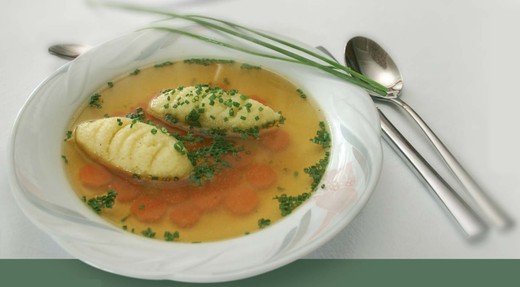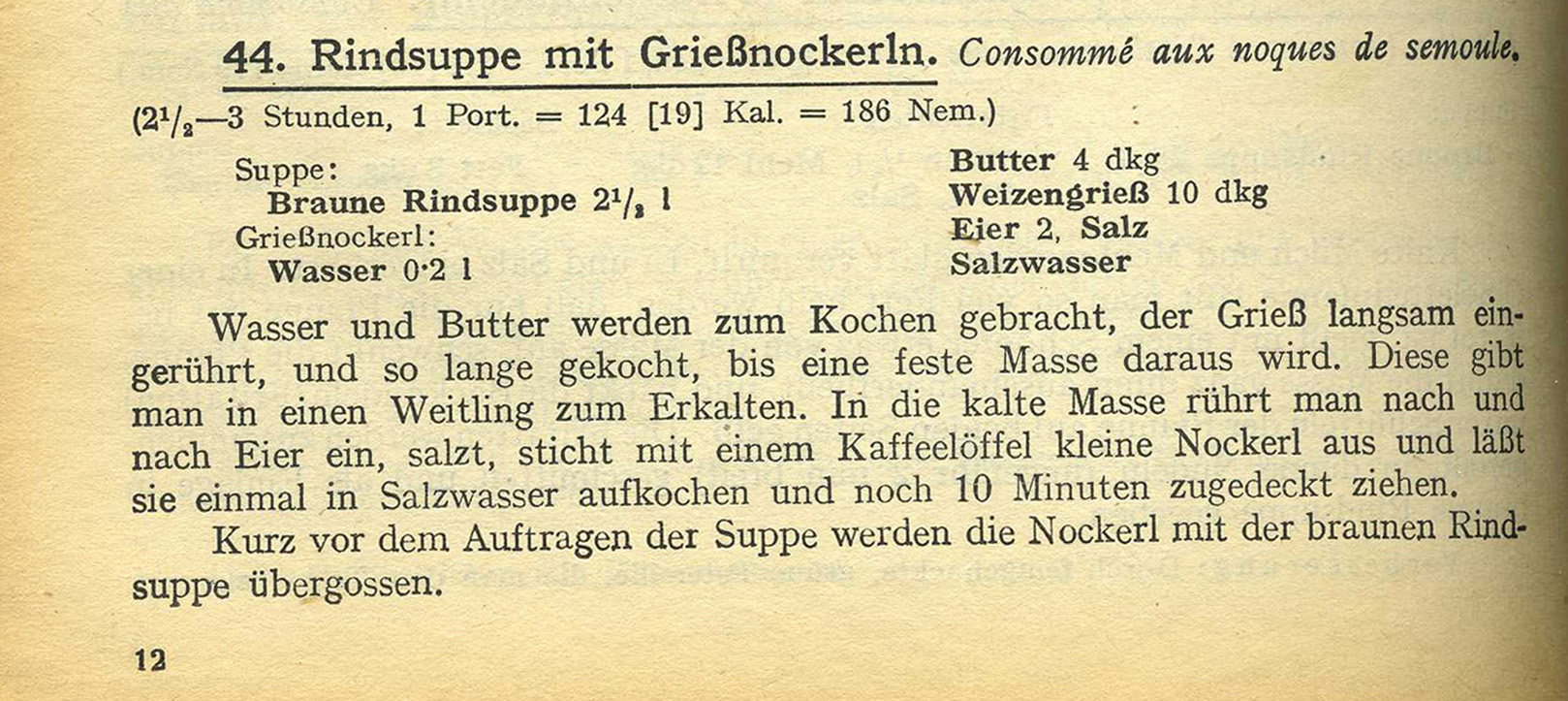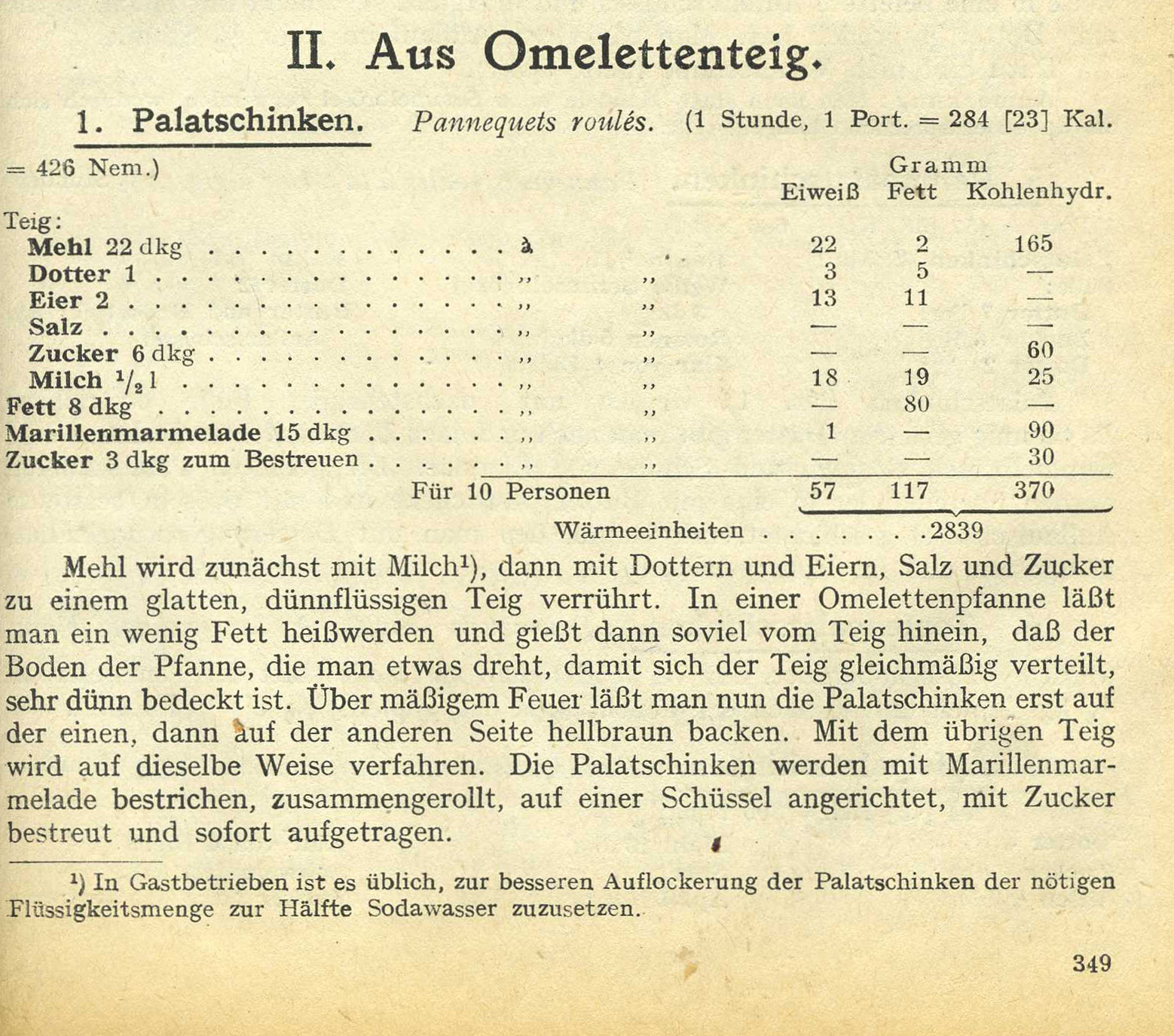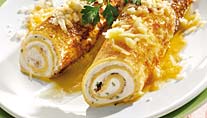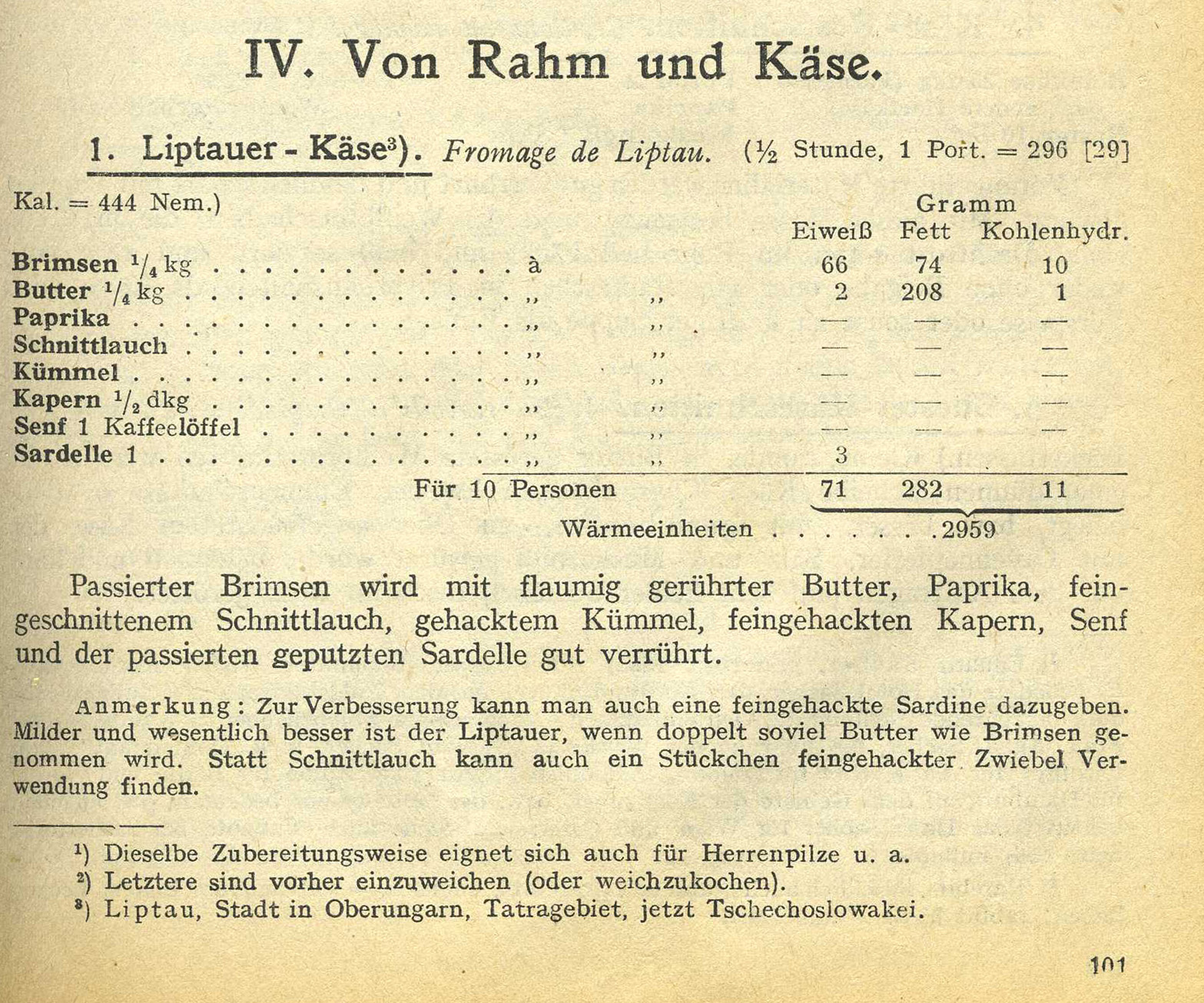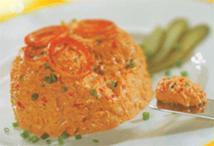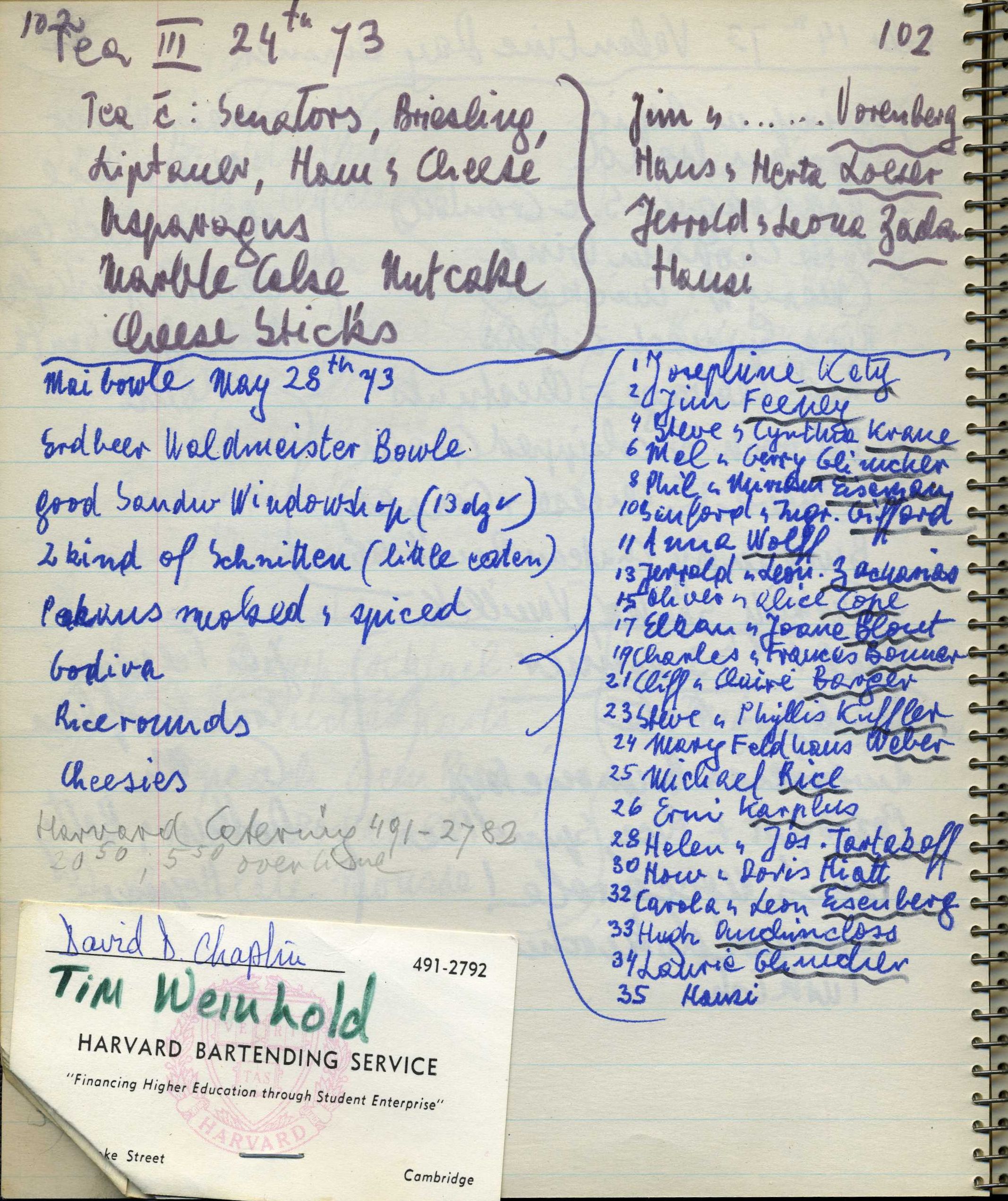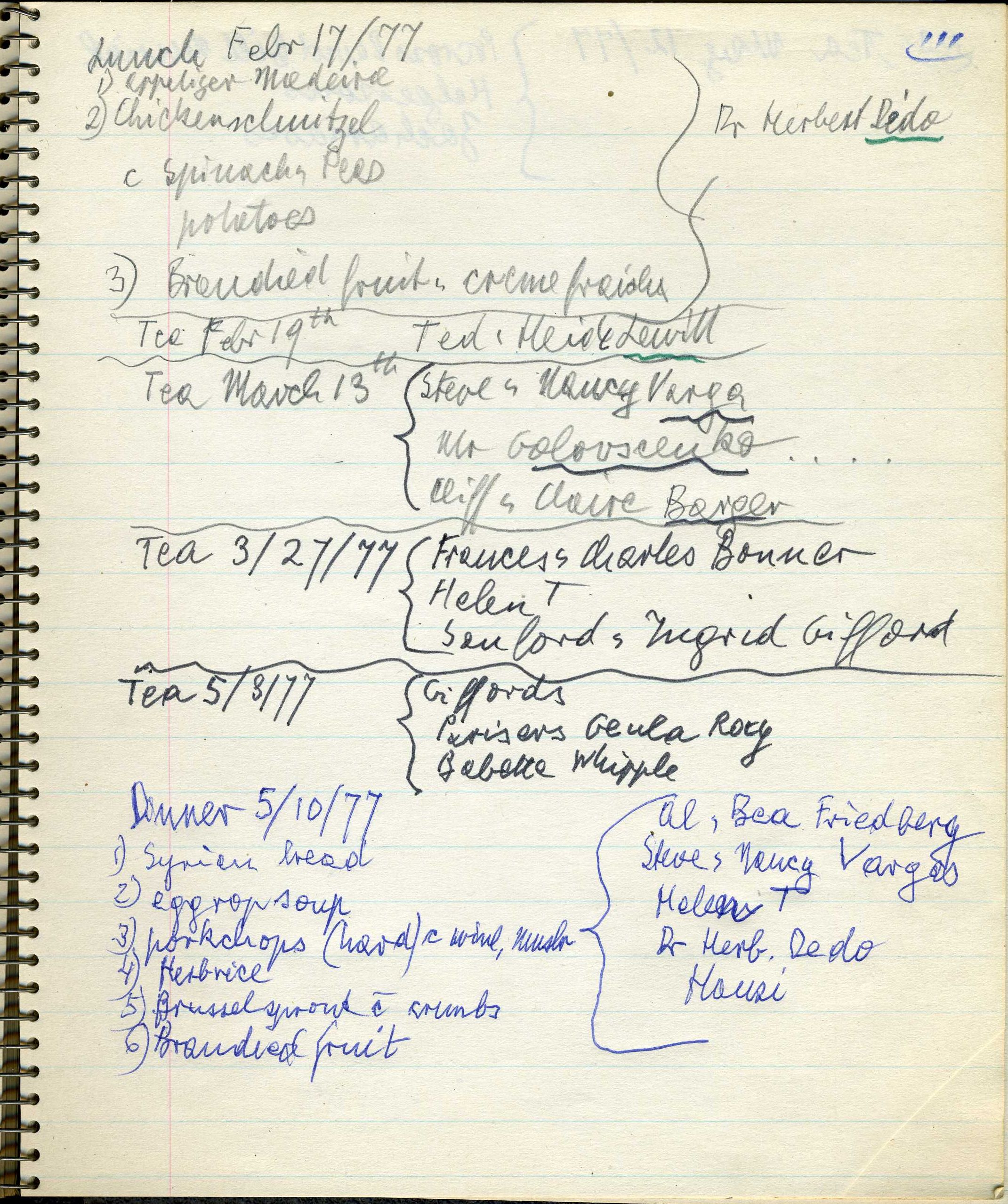Grete Bibring: A Culinary Biography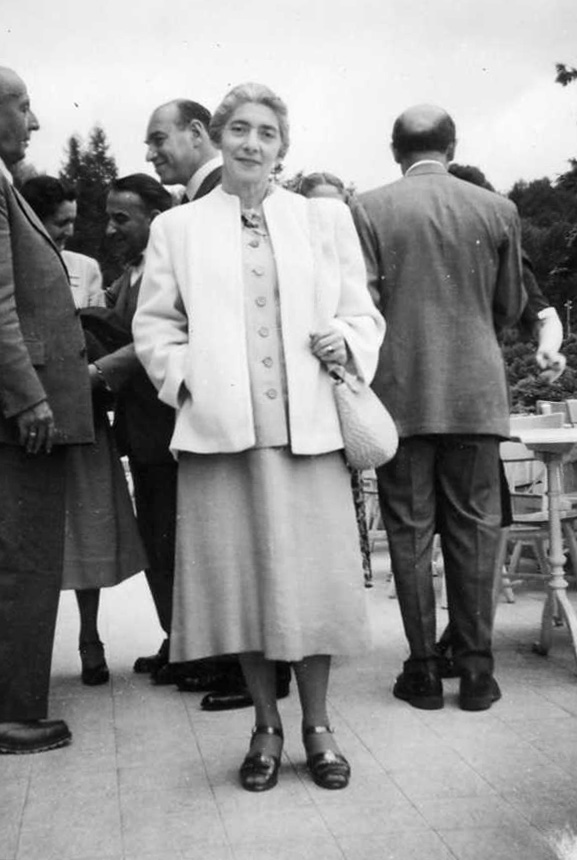 Dr.
Grete
Bibring was an intellectually precocious youth, a medical student with
a penchant
for problem solving, and an accomplished clinician and
teacher. Her affinity for medicine and her deductive skill were
complemented by an intuition born of compassion. Dr. Bibring
cared deeply for her friends and family, surrounding herself with loved
ones during times of both suffering and triumph. In a
memorial address for Dr. Bibring, Helen Tartakoff speaks
of tense times in Austria during the Nazi occupation.
Tartakoff remembers Bibring as a reliable and stolid force during that
time,
explaining: Dr.
Grete
Bibring was an intellectually precocious youth, a medical student with
a penchant
for problem solving, and an accomplished clinician and
teacher. Her affinity for medicine and her deductive skill were
complemented by an intuition born of compassion. Dr. Bibring
cared deeply for her friends and family, surrounding herself with loved
ones during times of both suffering and triumph. In a
memorial address for Dr. Bibring, Helen Tartakoff speaks
of tense times in Austria during the Nazi occupation.
Tartakoff remembers Bibring as a reliable and stolid force during that
time,
explaining: with the resourcefulness,
courage, and reality-orientation which have
always been characteristic of her, Grete decided to prepare for
expatriation by learning to cook. She invited a group of
friends to Sunday lunch to partake of her piece de resistance, Poulet
à
la Bonne Femme!
Not only was the lunch excellent but the opportunity to enjoy a quiet
family meal, in a city teeming with tension, left an unforgettable
impression.
This woman neither lost her equilibrium in the face of grave danger nor
relaxed her high standards.
Grete Bibring cherished her personal relationships above all else. Time spent with loved ones was often passed at the dinner table, and the meticulously recorded menus and guestlists of these meals create a unique record of how Dr. Bibring created a life nourishing to mind, body, and spirit. Household Notebook,
1927-1938
Household Notebook, 1938, 1941-1959 Household Notebook, 1960-1977 Larger View of Images Household Notebook, 1927-1938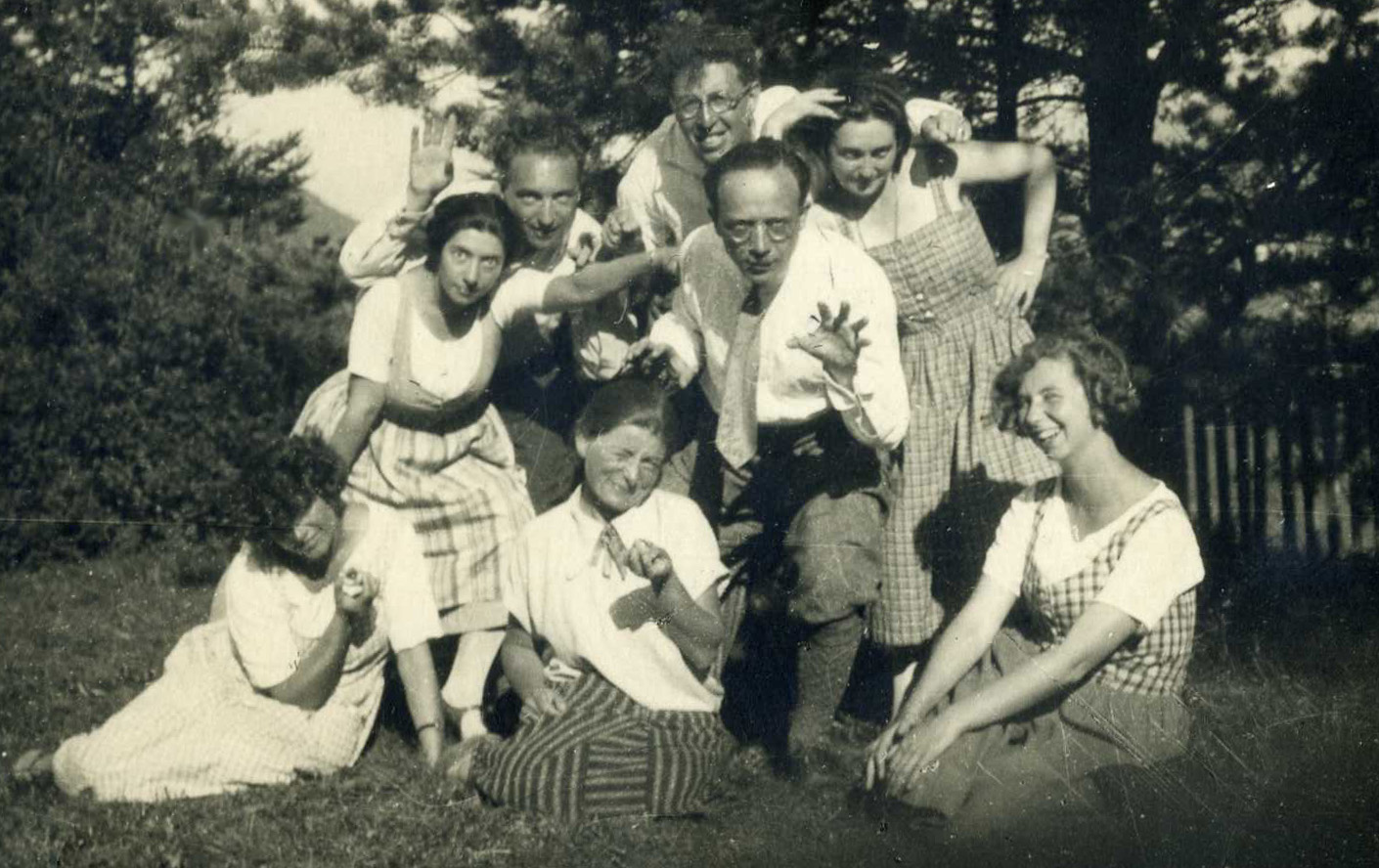 Dr
Bibring's household notebooks begin recording menus and guest lists
in the late fall of 1927. The information contained in these
entries reflects the optimism and youthful enthusiasm felt by the
Bibrings and their friends in Vienna. Central European and
traditional Austrian cuisine is featured heavily in meals
prepared for a variety of guests from Vienna's thriving community of
psychoanalysts. Many menus also feature lighthearted courses, such as
Grete
Bibring's special strawberry dessert, "Erdbeeren
à la
Grete." Dr
Bibring's household notebooks begin recording menus and guest lists
in the late fall of 1927. The information contained in these
entries reflects the optimism and youthful enthusiasm felt by the
Bibrings and their friends in Vienna. Central European and
traditional Austrian cuisine is featured heavily in meals
prepared for a variety of guests from Vienna's thriving community of
psychoanalysts. Many menus also feature lighthearted courses, such as
Grete
Bibring's special strawberry dessert, "Erdbeeren
à la
Grete."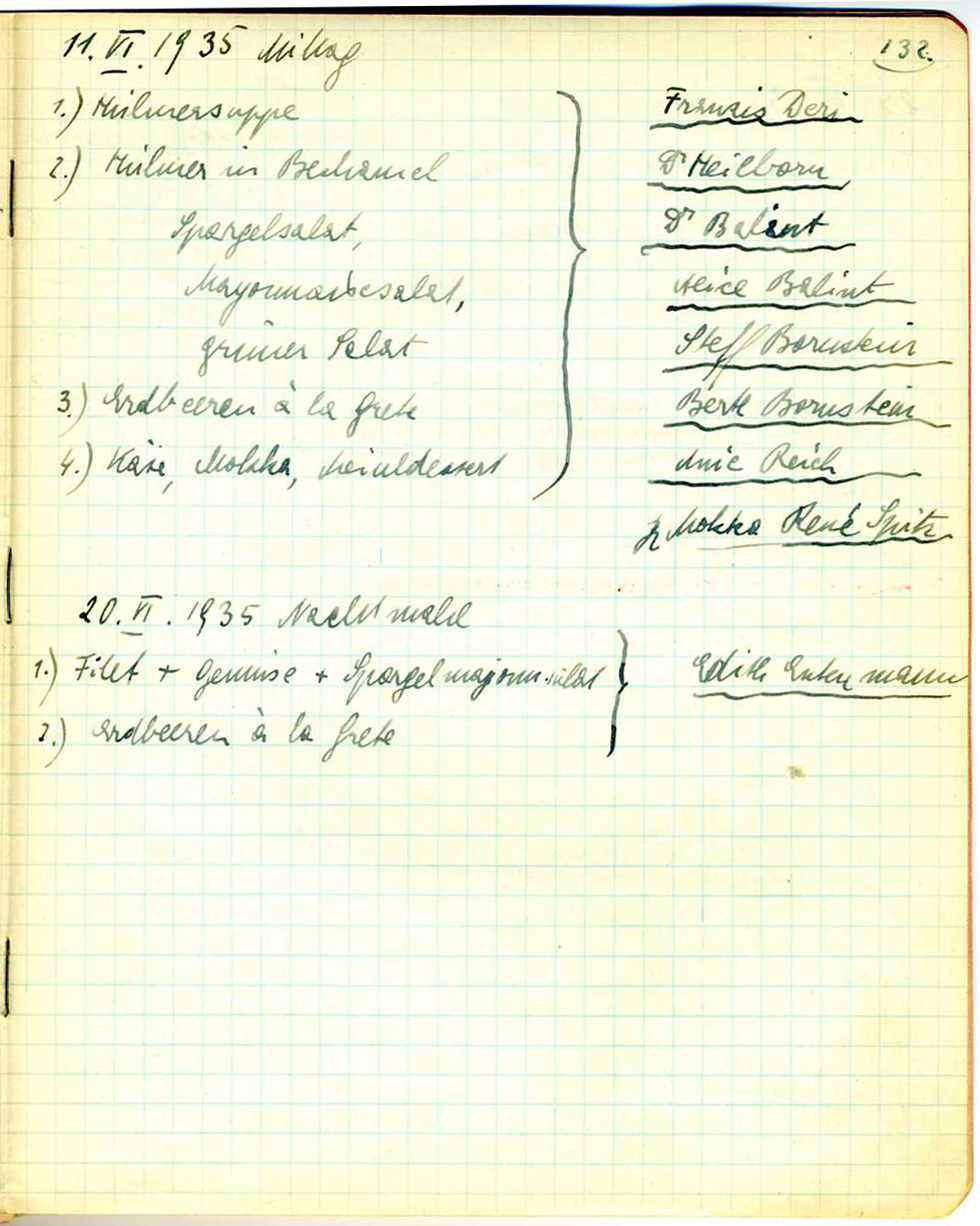 The menus of the late 1920's and the better part of the 1930's also reflect a closeness of the Vienna psychoanalysts that would be fractured by the Anschluss and Second World War. A menu entry for the 6th of November, 1935, illustrates this clearly. Of the eight guests attending lunch at the Bibring home, not one would settle near the Bibrings, in Boston, after the Nazi invasion of Austria. Though not in Boston, most of the guests at the November luncheon would evetually settle in the United States. After time spent in Berlin, Paris, and new York City, Rene Spitz would make Denver his home. Frances Deri and Hannah Heilborn would both move to Los Angeles in the late 1930's, while Annie Reich and Berte Bornstein would move to New York City during that same time period. Both Reich and Bornstein would go on to spend time in Pennsylvania - Pittsburgh and Philadelphia, respectively. Steff Bornstein, as well as Michael and Alice Balint, would leave Austria, but not Europe. Ms. Bornstein died in Prague in 1939. The Balints emigrated to London in 1939, where Alice died a premature death, just six months after arriving. 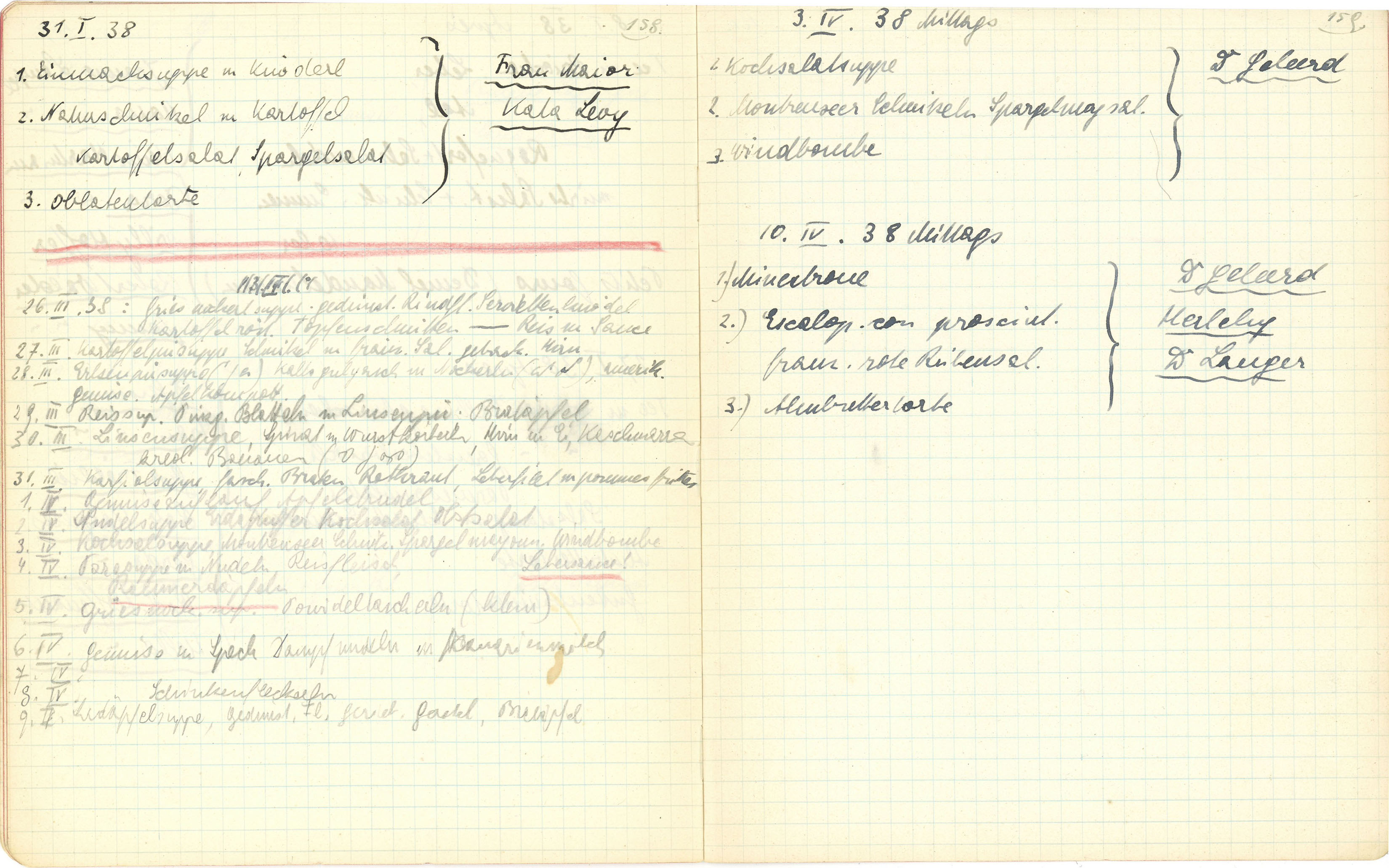 By
the latter part of
the 1930's, Hitler's grip on Europe was
tightening. Every aspect of day-to-day
life was effected - especially for Europe's Jewish population. These
changes in lifestyle are reflected in Grete's household notebooks,
especially in the months preceding the Anschluss. By
the latter part of
the 1930's, Hitler's grip on Europe was
tightening. Every aspect of day-to-day
life was effected - especially for Europe's Jewish population. These
changes in lifestyle are reflected in Grete's household notebooks,
especially in the months preceding the Anschluss.Menu entries become crowded and seem hurried, and guest lists change as friends and colleagues flee Vienna. The shifting guest lists also reflect visits from Walter Langer, one of the Bibring's American colleagues working to aid Austrians in their escape. Langer, a Boston native, would ultimately become best known for his wartime psychological analysis of Adolf Hitler.
The menus recorded in the household notebook from 1938 also indicate a change in the food being prepared for guests. Entrées become simpler and meals lean increasingly toward what might be best described as "comfort food." One example of this comfort food is Griessnockerlsuppe, listed in the menus for both the 26th of March and the 5th of April. This soup of beef broth and dumplings, which gain their distinctive shape by being dropped from teaspoons, is a classic offering in Austria and southern Germany. Household Notebook, 1938, 1941-1959 After fleeing Vienna with Freud's party in June 1938, the Bibrings settled temporarily in London, then permanently in the Boston area. Not surprisingly, Grete's household notebooks reflect this period of chaos and movement, with pages providing London menus torn from one notebook and tucked inside the cover of a later, Boston-based notebook. Menu entries also show evidence of Dr. Bibring's assimilation to life in America; entries become a mixture of both German and English text, and many of the guests most often entertained in Vienna go missing from the pages of this household notebook. As the Bibrings became settled in greater Boston and stability returned to their lives, order returned to Dr. Bibring's household notebooks. Positive developments in both Grete's and Edward's lives also begin to show in the recorded events and guest lists of the Bibring household. In particular, with Grete's appointment to Chief of Psychiatry at Beth Israel hospital, punch socials for her new coworkers and residents become a normal occurrence. 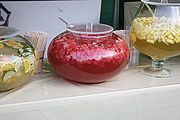 These
punch social menus further reflect Dr. Bibring's
unique American experience in a surprising way - the menus
show
how Dr. Bibring must reconcile her enthusiasm and success at work with
the realities of a country at war. For the household
notebooks and the menus contained therein, that means rationing. The
heavy meat entrées prepared in traditional Austrian fashion
disappear
from
the menus. Grete's planned meals show an increased use of
decidedly simple, more American foods and beverages, such as Cherry
Coke and sandwiches. Dr. Bibring still manages to serve
some Austrian favorites, such as the strawberry or pineapple punches
often
served to coworkers. Served with simple snacks, this
combination of fruit, wine, and sugar was a satisfying treat. These
punch social menus further reflect Dr. Bibring's
unique American experience in a surprising way - the menus
show
how Dr. Bibring must reconcile her enthusiasm and success at work with
the realities of a country at war. For the household
notebooks and the menus contained therein, that means rationing. The
heavy meat entrées prepared in traditional Austrian fashion
disappear
from
the menus. Grete's planned meals show an increased use of
decidedly simple, more American foods and beverages, such as Cherry
Coke and sandwiches. Dr. Bibring still manages to serve
some Austrian favorites, such as the strawberry or pineapple punches
often
served to coworkers. Served with simple snacks, this
combination of fruit, wine, and sugar was a satisfying treat.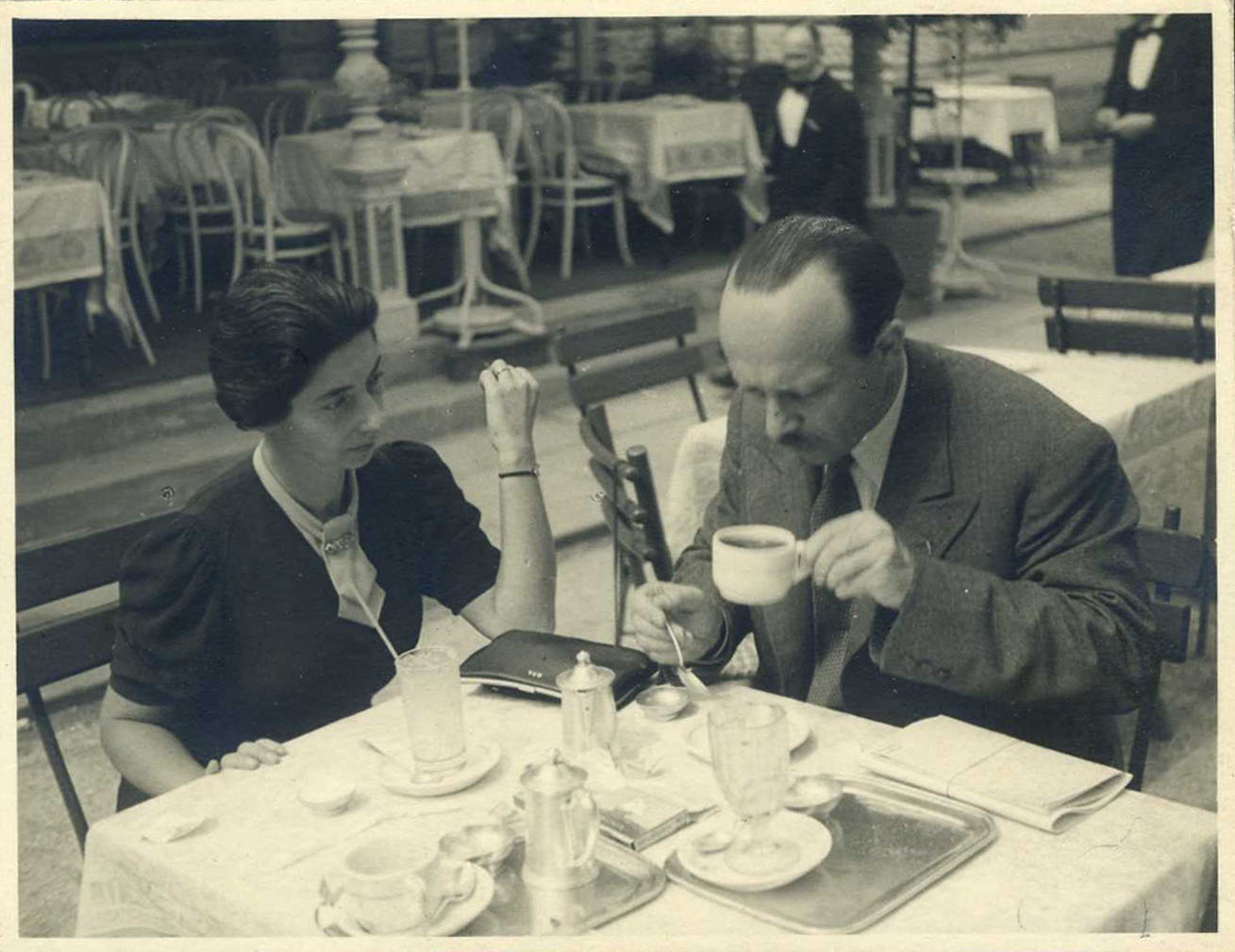 As
the years progress, the menus again
reveal a period of change in
Grete
Bibring's life - though the changes reflected in the latter pages of
this household notebook are not positive. By July of 1958,
Bibring's large punch socials have ceased. From November of
that same year through mid-January of 1959, there is no record of Grete
Bibring entertaining any guests at all. These dates coincide
with the declining health and eventual death of Edward Bibring. Grete
Bibring's first entry after Edward's death, dated the
25th of January, 1959, is a brunch for just three listed guests. The
simple brunch menu is anchored by a traditional Austrian
entrée,
Palatschinken. Palatschinken are similar to crêpes and are
served stuffed with sweet or savory fillings. In this
instance, Bibring serves the Palatschinken stuffed with chicken liver. As
the years progress, the menus again
reveal a period of change in
Grete
Bibring's life - though the changes reflected in the latter pages of
this household notebook are not positive. By July of 1958,
Bibring's large punch socials have ceased. From November of
that same year through mid-January of 1959, there is no record of Grete
Bibring entertaining any guests at all. These dates coincide
with the declining health and eventual death of Edward Bibring. Grete
Bibring's first entry after Edward's death, dated the
25th of January, 1959, is a brunch for just three listed guests. The
simple brunch menu is anchored by a traditional Austrian
entrée,
Palatschinken. Palatschinken are similar to crêpes and are
served stuffed with sweet or savory fillings. In this
instance, Bibring serves the Palatschinken stuffed with chicken liver.
Household Notebook, 1960-1977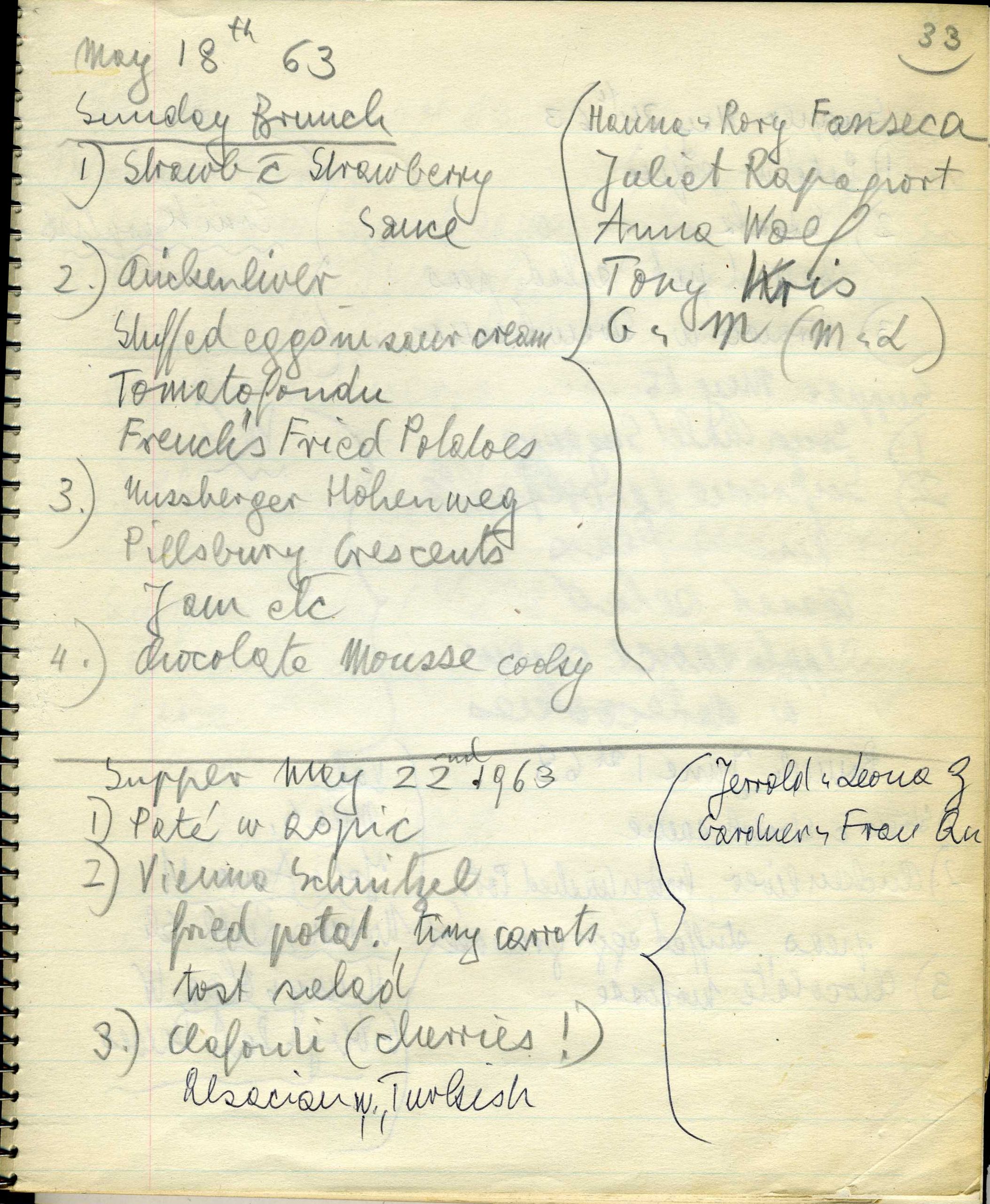 Dr.
Bibring's third and final notebook
spans the years 1960 to 1977, and reflects a return to the busy
entertaining schedule she maintained in the mid 1950s. Though
they are carefully numbered from 1 to 32, the initial pages of this
notebook are mostly loose leaves of paper listing large punch social
guest lists or multi-course menus meant to feed large parties. Dr.
Bibring's third and final notebook
spans the years 1960 to 1977, and reflects a return to the busy
entertaining schedule she maintained in the mid 1950s. Though
they are carefully numbered from 1 to 32, the initial pages of this
notebook are mostly loose leaves of paper listing large punch social
guest lists or multi-course menus meant to feed large parties.Grete Bibring's menus have also adapted over time, showcasing distinctly American foods. In this 1963 brunch menu, Grete references two brand names: French's and Pillsbury. While the French's fried potatoes may refer to a potato pancake mix no longer being made, Pillsbury crescent rolls remain a popular offering on many American tables. Dr. Bibring's third menu book blends uniquely American foods with international offerings and Austrian favorites. One such favorite, served regularly as an appetizer with pâté and crackers or toast points, is Liptauer. Liptauer is made with a blend of cheese, fish, and spices. While it is sometimes said that families create and maitain their own unique Liptauer recipe variations, nearly all recipes seem to revolve around anchovies, capers, and mustard.
 Though
Grete struggled with her health in her later years, she continued to
maintain an active social schedule. Visitors to the Bibring
home in Cambridge were a common site, for punch socials and - later on
- for small, private teas. The two menus shown below are
indicative of the adaptations Grete made over time. The first
shows the menu and guest list for a large punch social, unique in that
it is the only entry in all three notebooks that specifically indicates
using catering services. Sandwiches were purchased at the well-known
"Window
Shop," and a business card for a Harvard University bartender is
stapled to the bottom corner of the page. The second menu,
shown on the right, is from the final page of Dr. Bibring's notebook.
It lists information regarding a series of afternoon teas
held when Dr. Bibring's health was in decline. Though the inclusion of
menu items
is incomplete, guest lists are clearly recorded. These final gatherings
show visits from Dr. Helen Tartakoff (mentioned in the introduction of
this
exhibit), as well as Drs. Sanford and Ingrid Gifford. Though
Grete struggled with her health in her later years, she continued to
maintain an active social schedule. Visitors to the Bibring
home in Cambridge were a common site, for punch socials and - later on
- for small, private teas. The two menus shown below are
indicative of the adaptations Grete made over time. The first
shows the menu and guest list for a large punch social, unique in that
it is the only entry in all three notebooks that specifically indicates
using catering services. Sandwiches were purchased at the well-known
"Window
Shop," and a business card for a Harvard University bartender is
stapled to the bottom corner of the page. The second menu,
shown on the right, is from the final page of Dr. Bibring's notebook.
It lists information regarding a series of afternoon teas
held when Dr. Bibring's health was in decline. Though the inclusion of
menu items
is incomplete, guest lists are clearly recorded. These final gatherings
show visits from Dr. Helen Tartakoff (mentioned in the introduction of
this
exhibit), as well as Drs. Sanford and Ingrid Gifford.
Conclusion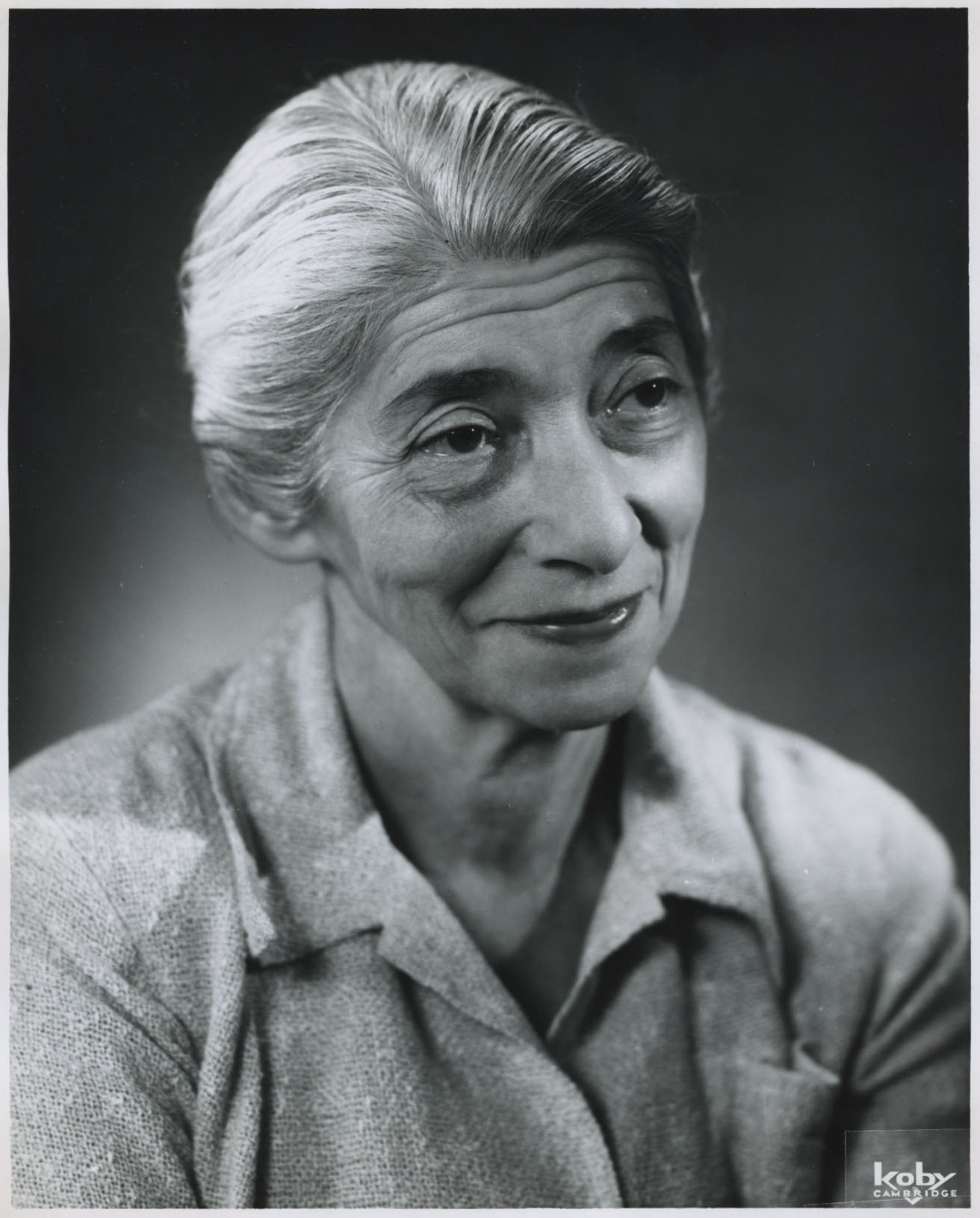 There are many ways to tell the life story of a woman like Dr. Grete Bibring. A traditional biography creates an image of a determined and compassionate woman, while her professional records tell the story of a deeply intelligent and insightful doctor. A life story drawn from the pages of menus, recipes, and guestlists brings the varied biographies together, showing Grete Bibring for the unique and celebrated woman she was. ~Meghan Hardison,
December 2009
References(n.d.). Bowle. Retrieved November 6, 2009, from Wikipedia (Germany): http://de.wikipedia.org/wiki/Bowle Edward and Grete L. Bibring Collection. The Boston Pyschoanalytic Society and Institute Archives. Boston, MA. Gattinger, C. (n.d.). Wein & Kaese; Kaese & Wein. Retrieved November 6, 2009, from Johann Gisperg; Weingut: http://www.weingut-gisperg.at/ (2009). Gefüllte Palatschinken mit Käse. Retrieved November 6, 2009, from T Online: http://rezepte.t-online.de/rezepte/gefuellte-palatschinken-mit-kaese Gifford, S. & Menashi, A. (Comp.). (1979). In Memoriam: Edward Bibring (1895-1959), Grete Bibring (1899-1977): Memorial Addresses and Catalogue of the Edward and Grete L. Bibring Collection. Boston: The Boston Pyschoanalytic Society and Institute. Gifford, S., Jacobs, D., Goldman, V., & Boston Psychoanalytic Society and Institute (Eds.), (2005). Edward Bibring Photographs the Psycholanalysts of His Time, 1932-1938. Hillsdale, NJ: The Analytic Press, Inc. Hess, O. & Hess, A. [1939]. Wiener Kueche, 27 Auflage. Wien: Franz Deuticke. Simmel, E. (1946). Otto Fenichel. Int. J. Psycho-Anal., 27:67-71. Sorlat, (n.d.). Griessnockerlsuppe. Retrieved November 6, 2009, from Hotel Irmguard: http://leckeres-oesterreich.de/griessnockerlsuppe (1940). Steff Bornstein-Windholzova. Int. J. Psycho-Anal., 21:116. |
